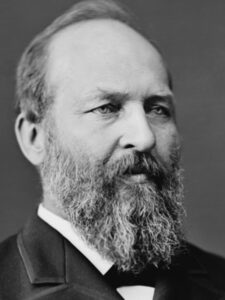» posted on Thursday, July 4th, 2024 by Linda Lou Burton
#20. Garfield, James Abram
Linda Lou Burton posting from Little Rock, Arkansas – James Abram Garfield (November 19, 1831 – September 19, 1881) was the 20th president of the United States, from March 4, 1881, until his death by assassination six and a half months later. Two words come to mind when I read the story of James’ life: What If? What if his presidency had lasted more than six months? He had high ideals – what impact might he have made on our country? What if x-ray had already been invented when he was shot? His wound wouldn’t even be considered serious today, and he wouldn’t have suffered the infection caused by endless probing with unsterilized fingers, and instruments. James Garfield overcame the poverty he was born into. He studied so hard and learned so much he graduated Phi Beta Kappa. He built a strong enough marriage with Lucretia Rudolph that they had seven children together, and she was there at his bedside during those last awful months.
Would I invite this man to my party? Probably not. A pallor of sadness hung over James Garfield. Things just didn’t seem to work out for him – and this was a guy who spoke Latin and Greek and had the mathematical talent to develop a trapezoid proof of the Pythagorean theorem! He once wrote “I lament that I was born to poverty, and in this chaos of childhood, seventeen years passed before I caught any inspiration … a precious 17 years when a boy with a father and some wealth might have become fixed in manly ways.”
Well It Was Lousy
Yes, James was born in a log cabin. He was the youngest of five children, and yes, his father Abram died shortly after he was born. Leaving his mother Eliza in a bad spot – so she remarried quickly, only to leave her second husband just as quickly (one could suspect he was not a kindly person). Divorce was scandalous in those days, and times were tough for the family. Eliza loved to tell James stories of their ancestors – especially the Welch side of the family, and the “knight of Caerffili Castle.” Outside of the house, James was bullied by the other kids; he escaped by reading every book he could find. At the age of 16 he left home.
He first found work on a canal boat, managing the mules. That was short-lived; he became ill and returned home where Eliza finally persuaded him to go to school. In 1848 his life began to shift – he enrolled at Geauga Seminary, where he became especially interested in languages and elocution, and wrote “I love agitation and investigation and glory in defending unpopular truth over popular error.” Of course he worked during his school years – he was a carpenter’s assistant, a janitor, and most frequently, a teacher. Lucretia Rudolph was a fellow 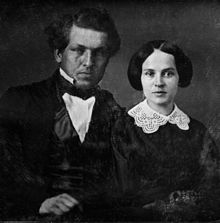 student at Hiram College – James wooed her while teaching her Greek. And he had a religious awakening, got baptized in the Chagrin River, and attended many camp meetings. He also developed a regular preaching circuit. As he completed all a school had to offer, he moved on to the next until finally enrolling at Williams College in Massachusetts, where, as I mentioned, he graduated Phi Beta Kappa. A pretty darned good student.
student at Hiram College – James wooed her while teaching her Greek. And he had a religious awakening, got baptized in the Chagrin River, and attended many camp meetings. He also developed a regular preaching circuit. As he completed all a school had to offer, he moved on to the next until finally enrolling at Williams College in Massachusetts, where, as I mentioned, he graduated Phi Beta Kappa. A pretty darned good student.
He returned to Ohio as a “man of distinction” teaching at Hiram; in 1857 was made its president, and began to get involved in politics. He married Lucretia in 1858 (he was 27, she was 26), began to read law, and was admitted to the bar in 1861 at the age of 30.
Government Positions
- Member of Ohio State Senate, 1859-61
- Member of U.S. House of Representatives, 1863-80
- Elected to United States Senate, 1880
- President of the United States, 1881
Now here’s a quirky thing:
 On election day, November 2, 1880, he was at the same time a member of the House, Senator-elect and President-elect. Lucky guy, you’d think! He hadn’t even sought out the presidency, and received only a few thousand more popular votes than Democrat Hancock. But that was enough – he was inaugurated as President of the United States March 4, 1881, along with his vice-president Chester Arthur. His predecessor Rutherford Hayes was there; James’ mother Eliza was there too – the first time a president’s mother had attended an inauguration. The Inaugural Ball at the beautiful new Smithsonian Arts and Industries Building that evening featured a large “Statue of America” in the museum’s rotunda; John Phillip Sousa directed the evening’s music. It should have been the start of something good. But something was awry from the first. James was an extremely competent public speaker, but his inaugural speech fell flat. And in only a few months, the unthinkable happened.
On election day, November 2, 1880, he was at the same time a member of the House, Senator-elect and President-elect. Lucky guy, you’d think! He hadn’t even sought out the presidency, and received only a few thousand more popular votes than Democrat Hancock. But that was enough – he was inaugurated as President of the United States March 4, 1881, along with his vice-president Chester Arthur. His predecessor Rutherford Hayes was there; James’ mother Eliza was there too – the first time a president’s mother had attended an inauguration. The Inaugural Ball at the beautiful new Smithsonian Arts and Industries Building that evening featured a large “Statue of America” in the museum’s rotunda; John Phillip Sousa directed the evening’s music. It should have been the start of something good. But something was awry from the first. James was an extremely competent public speaker, but his inaugural speech fell flat. And in only a few months, the unthinkable happened.
The End Was Too Close To The Beginning
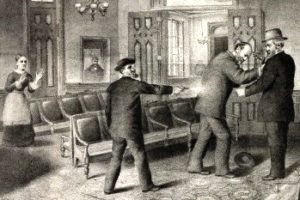 On July 2, 1881, Charles J Guiteau shot and fatally wounded President James A Garfield in the lobby of the Baltimore & Ohio Railroad Depot in Washington, DC as he yelled, “I am a stalwart and Arthur is now President of the United States!” Guiteau blamed the president for not selecting him for a job at the US Consulate in Paris.
On July 2, 1881, Charles J Guiteau shot and fatally wounded President James A Garfield in the lobby of the Baltimore & Ohio Railroad Depot in Washington, DC as he yelled, “I am a stalwart and Arthur is now President of the United States!” Guiteau blamed the president for not selecting him for a job at the US Consulate in Paris.
James’ presidency was cut so short there isn’t enough of a legacy to rank him among the worst and best. He was the last president to be born in a log cabin and one of the most well-read of our presidents. Maybe that childhood bullying toughened him up; as soon as he took office he pioneered the Pendleton Civil Service Reform Act, making it a law that all government jobs be granted on the basis of merit and merit alone. And then was killed by a man wanting a job. At least, that’s part of the story.
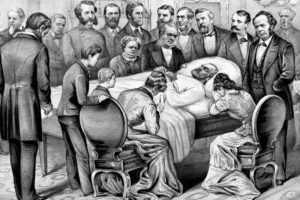 President Garfield did not die immediately, but lingered for eleven weeks, during which time surgeons repeatedly attempted to find the bullet that had lodged in his back. In spite of Joseph Lister’s discoveries regarding the use of antiseptics in surgery, the practice of sterilization had not caught on, and Garfield’s wound was probed by many unwashed fingers. The resulting infection, not the bullet, caused Garfield’s eventual death on September 19, 1881. Vice president Chester A Arthur became president of the United States on September 20.
President Garfield did not die immediately, but lingered for eleven weeks, during which time surgeons repeatedly attempted to find the bullet that had lodged in his back. In spite of Joseph Lister’s discoveries regarding the use of antiseptics in surgery, the practice of sterilization had not caught on, and Garfield’s wound was probed by many unwashed fingers. The resulting infection, not the bullet, caused Garfield’s eventual death on September 19, 1881. Vice president Chester A Arthur became president of the United States on September 20.
Addressing A Problem
Garfield’s incapacitation sparked a constitutional crisis, as the Cabinet was divided over whether the vice president should assume the office of the incapacitated president or merely act in his stead. It was not until 1967, with the passage of the Twenty-fifth Amendment to the Constitution, that the question of the succession of power was fully addressed. Today, the vice president assumes the office of president in the event that a sitting president is “unable to discharge the powers and duties of his office.”
In spite of Guiteau’s manifest insanity at his trial, his attorneys were unable to gain an acquittal on that basis—it was, however, one of the first uses of the modern insanity defense in a criminal court. After a six-month trial that sparked great public interest, Guiteau was found guilty and hanged on June 30, 1882.
Closure
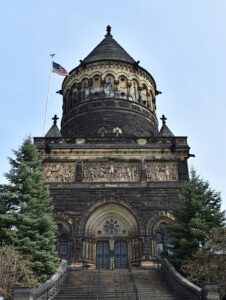 James Abram Garfield was 50 years old when assassinated. Lucretia was 49 and the children were still young; Harry was 18, James 16, Mary 14, Irvin 11, and Abram 9 when they, and James’ mother Eliza, left the White House after their brief stay. A $350,000 trust fund was raised for Lucretia and the children by financier Cyrus Field. Eliza lived another seven years; Lucretia another 37; she was active in preserving the records of James’ career and creating a wing to the home that became a presidential library of his papers. Eliza is buried beside her husband in Roselawn Cemetery, Solon, Ohio. Lucretia is buried beside James in the James A Garfield Memorial, Lake View Cemetery, Cleveland, Ohio. Five terra cotta panels surround the balcony depicting James’ life; the last shows him lying in state in the Capitol rotunda. Lake Erie’s shore is visible, on a clear day.
James Abram Garfield was 50 years old when assassinated. Lucretia was 49 and the children were still young; Harry was 18, James 16, Mary 14, Irvin 11, and Abram 9 when they, and James’ mother Eliza, left the White House after their brief stay. A $350,000 trust fund was raised for Lucretia and the children by financier Cyrus Field. Eliza lived another seven years; Lucretia another 37; she was active in preserving the records of James’ career and creating a wing to the home that became a presidential library of his papers. Eliza is buried beside her husband in Roselawn Cemetery, Solon, Ohio. Lucretia is buried beside James in the James A Garfield Memorial, Lake View Cemetery, Cleveland, Ohio. Five terra cotta panels surround the balcony depicting James’ life; the last shows him lying in state in the Capitol rotunda. Lake Erie’s shore is visible, on a clear day.

